
Jasmine and Sam of Focus E15 Mums hold the pot plants they have been given for moving into the Carpenters Estate flats
Housing is fast becoming a really major issue in the UK, and particularly in London, where property prices and market rents have risen so much that most of those who work there can no longer afford to live there. The current minimum wage is £6.50 per hour, which works out to roughly £1050 per month for a typical worker without overtime. Those who get the London Living Wage are a little better off at around £1400 a month. Newspapers have recently been reporting on the tenants of the New Era Estate, a fairly typical inner London estate, currently paying rents of around £600 per month who are threatened with a rise to ‘market rents’ of around £2400 per month.
People may qualify for the misnamed Housing Benefit, (it’s really more a benefit for landlords), but the benefits cap introduced by the government (including an overall benefits cap of £500) make this totally inadequate in London. The only viable solution to the problem of keeping London running is a crash programme to build low-rent social housing, but neither of the major political parties is seriously proposing this, and while there is considerable building taking place in London, the vast majority of it is high rent private properties, many of which are being bought by overseas investors. Some simply leave them empty while property values soar, others rent them out to companies for employees here on short-term visits or as holiday lets.
Some Labour councils are among the worst offenders in this process, getting rid of social housing and profiting from sales to developers. Some have even made a mess of this, with Southwark Council reported to have lost millions in the costs of emptying the Heygate estate came to more than the bargain deal the developers made. Of course some individuals – both on the council and the developers – do nicely out of these schemes.
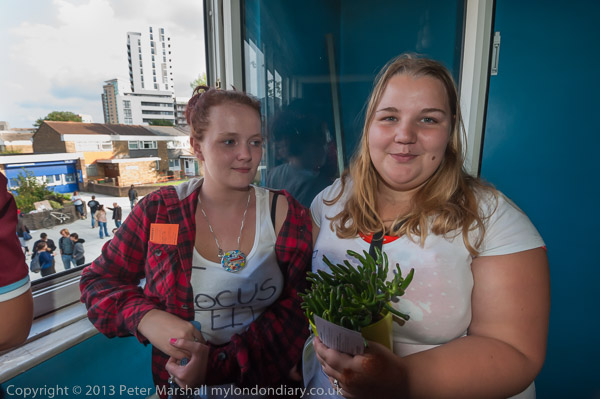
Jasmine and Sam in one of the Carpenters Estate flats while the Focus E15 MumsFirst Birthday Party continues outside
Newham Council, 100% Labour and with an elected Mayor have for ten years been trying to empty out and sell the Carpenters Estate, next to the centre of Stratford with its excellent transport links. It is truly a prime site, but unfortunately an earlier Labour council which had the interests of the people of the area in their heart built a well-planned council estate on it. One that people liked living in, and despite ten years of harassment, that some are still living in. In a borough with one of the worst housing shortages – and particularly of social housing – some properties there in excellent condition have been boarded up and empty for ten years.
Newham is also where one of the most vital campaigns over housing has been taking place, led by young mothers from a hostel for which the council decided to cut the funding to the housing association for a little over a year ago. The mothers, with some help from political activists, decided to make a stand together and fight, forming the Focus E15 Mums campaign. They refused to move away from London to be rehoused in Birmingham or Hastings or elsewhere, away from jobs, family and support systems as the council suggested. They set up a weekly protest stall on the high street every Saturday, protested at the housing association, at the council and elsewhere, and turned the insights they developed from their fight into a more general ‘housing for all’ protest against what they had come to realise was a policy of ‘social cleansing.’
I’m pleased that I’ve been able to photograph some of their protests and help through my pictures in gaining public attention to their fight, though I regret not having done more – but there are so many calls on my time. I was sorry, having been there to take these pictures of their re-occupation of a block of four flats at the centre of the Carpenters Estate, not to have found the time in the following couple of weeks to go back and record some of the events they staged there in what was always intended as a short-term occupation of the properties.
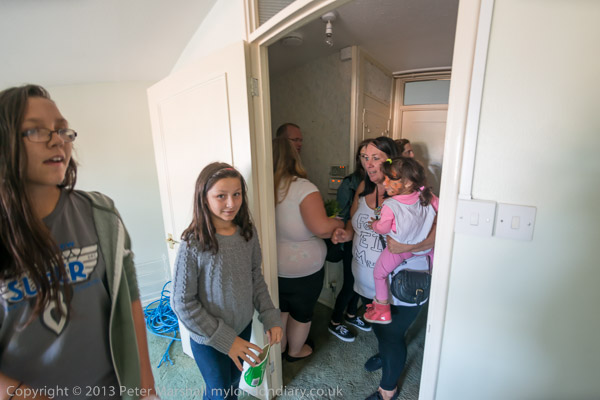
Photographically it was a little tricky in that there was little light inside the flats, and not enough for the pictures I took as I first went inside them, in the hall and on the stairs. Most of the metal grilles were still in place, with a little light coming through the pattern of holds in them, but parts were still very dark.
I’d anticipated this, and together with the knowledge that I’d be in a crowded and confined space had switched to the 16mm f2.8 while waiting to go inside – it was a long wait and I’d had plenty of time to think about it. One thing I often feel the lack of with my Nikon cameras is fast lenses. Back when I was using film one of my favourite Leica lenses was the 35mm f1.4 (it had cost me about a month’s salary when I bought it second-hand around 1980.) That aperture makes it 8 times as fast (3 stops) as the 16-35mm f4 Nikon lens.
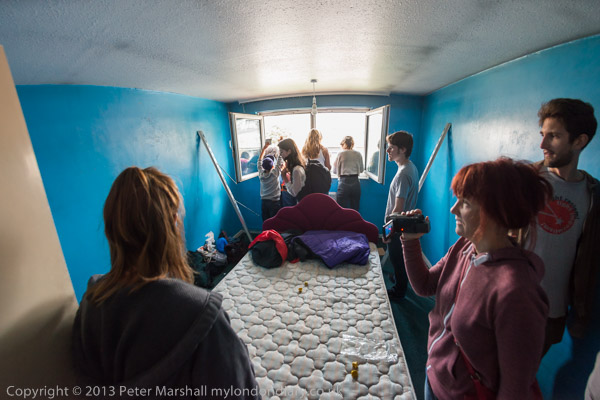
The two fastest Nikon lenses I own are the 16mm f2.8 fisheye and the 20mm f2.8 – and I’d left the latter at home. For many purposes not having fast glass doesn’t matter – particularly when we can know work at ISOs that were not viable in the days of film. You get the same shutter speed with an f4 lens at ISO 3200 and an f1.4 lens at ISO400. But this was a time when the f1.4 at ISO 3200 would have been rather better.
It doesn’t matter so much when your subjects are static. Even handheld with wide-angle lenses its quite possible to get sharp results at half a second – just not every time. The 16-35mm has image stabilisation, but I’m unconvinced it is of much significance with wide angles, though it certainly helps on longer lenses.
As we went in it was also quite crowded and the physical size of the 16-35mm can be a problem – the 16mm fisheye is a nicely compact lens. Once we got into the actual rooms things were easier, and I was able to take pictures with both the 16mm and the 16-35mm, and to lower the ISO, even down to ISO800 for some pictures.
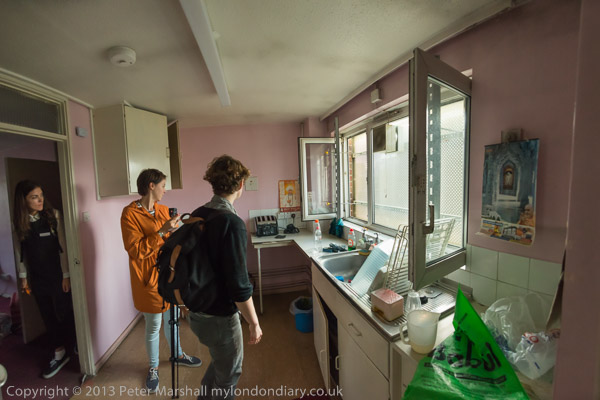
This was one of my favourite interiors, taken with the 16mm fisheye, processed with the Fisheye Hemi plugin to make the vertical and near-verticals more or less straight. The woman at the left looking into the room is in the darker corridor, but lit be light through the doorway (with a little help from Lightroom.) Stopped down to f5 makes everything sharp (the near objects at right just slightly less so), and even at ISO 2500 the quality is pretty good. Of course noise reduction, removal of chromatic aberration and fringing in Lightroom help. At 1/100th second there is perhaps just some very slight blurring of parts of the people as they look around, something that I like. On the original it is easy to zoom into the image and read the year 2014 on the calendar on the far wall.
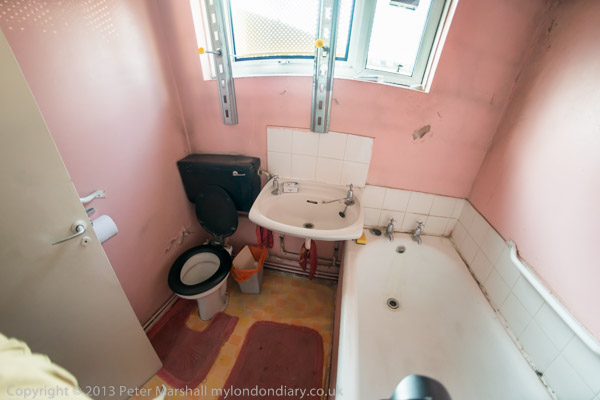
When the protesters moved in they found the flats in good order, and the water was still connected. The council soon turned it off after the occupation began. The picture above shows one of the perils of using the 16mm fisheye – and that large 16-35mm on the camera hanging down from my neck with its lens hood intruding into the image.

September 21st, when I took these pictures, was the second day of the London Open House Weekend (a week later than the rest of this country) so although it hadn’t been listed in the official catalogue, this was of course the Focus E15 Open House Day and there are many more pictures both of the party and the occupation of the flats in My London Diary.
______________________________________________________
My London Diary : Buildings of London : River Lea/Lee Valley : London’s Industrial Heritage
All photographs on this and my other sites, unless otherwise stated, are taken by and copyright of Peter Marshall, and are available for reproduction or can be bought as prints.
To order prints or reproduce images
________________________________________________________